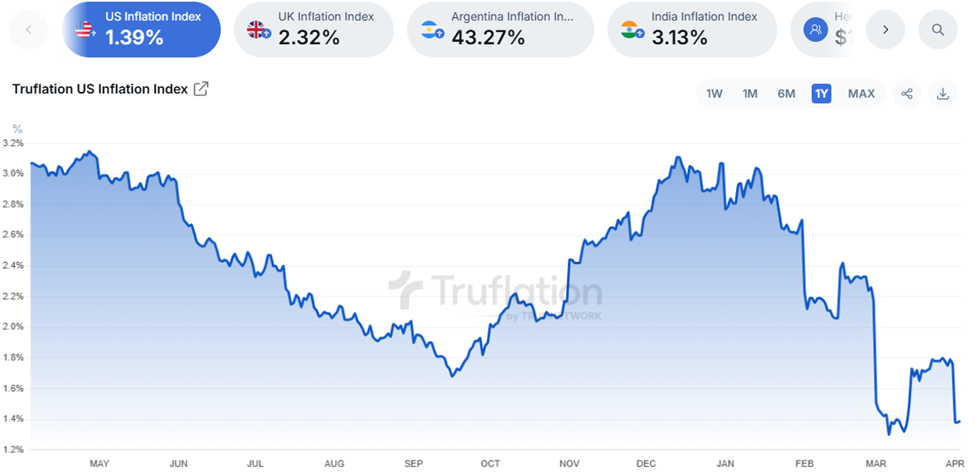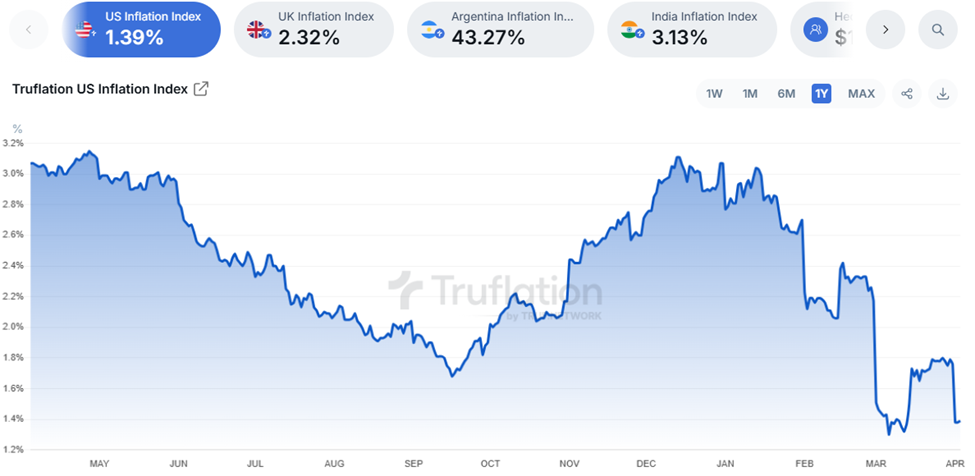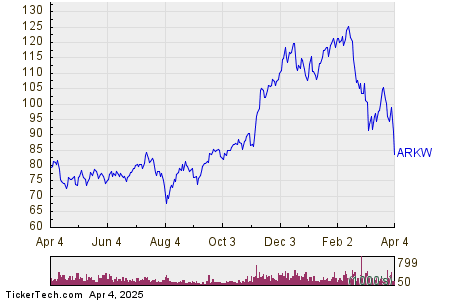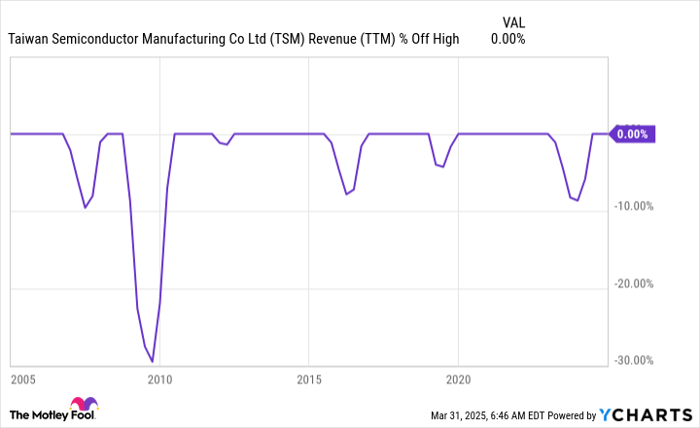Market Turmoil Following Trump’s Tariff Announcement: Key Insights and Risks
In the wake of President Trump’s “Liberation Day” tariff reveal yesterday, the investment markets are in freefall.
Yesterday afternoon, the President unveiled a sweeping tariff plan that exceeded market expectations. While Trump provided the clarification that investors sought, the clear image that has emerged points to a potential tariff war, posing risks to both economic growth and corporate profits.
As I write, panic selling is evident across various asset classes.
From stocks to gold, crypto, commodities, and the U.S. dollar, everything is declining—except bonds.
Investors are flocking to the safety of the 10-year Treasury, leading to a significant drop in its yield. Currently, the yield has decreased by 17 basis points, bringing the 10-year yield to 4.02%, marking its lowest level since October.
Remain Calm Amid Market Instability
Market sell-offs occur naturally within investing, and volatility is an aspect all investors must navigate.
Successful long-term investing hinges on discipline and patience. Downturns often present unique opportunities, and those who maintain their course tend to accumulate lasting wealth.
Remember, just a few months ago, the market reached an all-time high and will do so again in the future.
While you may wish to adjust your portfolio based on recent developments, we encourage doing so through rational analysis rather than impulsive reactions.
To assist, our Editor-in-Chief, Luis Hernandez, interviewed renowned investor Louis Navellier this morning. They delved into the current market chaos, the implications for U.S. and international manufacturing, the irrationality of today’s market movements, and why Louis remains optimistic about his stock selections.
To hear the full discussion, click here.
In the video, Luis shares specific stocks that Louis is currently targeting amid this market downturn, detailed in his Accelerated Profits newsletter. Click here for more information.
For those unfamiliar, in Accelerated Profits, Louis focuses on high-growth stocks poised for rapid appreciation. He employs a proprietary Stock-rating system to identify top-tier companies showing exceptional fundamentals and strong risk momentum.
In today’s volatile market, investing in solid fundamental stocks is vital; that’s precisely Louis’ strategy in Accelerated Profits.
Mixed Signals Regarding Inflation
Current indications suggest inflation is rapidly cooling, sparking discussions about the potential for deflation.
For instance, Truflation, an independent inflation index, reports a U.S. inflation rate of only 1.39%, demonstrating a consistent downward trend since late December.

Source: Truflation
Louis has pointed out signs of deflation in the global economy. While the financial media suggests tariffs drive inflation, deflation is already evident.
China is experiencing widespread deflation across numerous categories, with consumer prices having fallen to negative levels in February, and wholesale prices remaining negative for over two years.
Furthermore, the U.S. trade deficit has surged as goods have been offloaded in an attempt to preemptively avoid tariffs. This surplus in goods could also intensify deflationary pressures.
Consequently, the global economy may be at risk of entering a deflationary spiral.
Conversely, recent data from the Consumer Price Index (CPI) and the Personal Consumption Expenditures (PCE) Price Index indicate persistent price pressures.
The latest core CPI data, which excludes volatile food and energy prices, shows a year-over-year increase of 3.1%. Likewise, the recent core PCE figure rose to 2.8% year-over-year, up from 2.6% previously.
The pressing question remains: will inflation trend upward or downward?
Impact of New Tariffs on Prices
The recently introduced tariffs are anticipated to elevate production costs for companies, which they may pass on to consumers.
This scenario hints at increased prices.
Last week, the Federal Reserve Bank of Richmond released a report titled “How Might Fifth District Firms React to Changing Tariff Policies?”
The findings indicate that firms may react by raising prices when faced with unexpected cost increases:
Survey results from February indicated that nearly 75% of firms would increase prices if confronted with unexpected costs, with close to 60% likely to pass along the full amount or even more.
The degree of price increases will largely depend on the cost hikes resulting from the new tariff policies.
If consumer demand weakens due to these price hikes, the usual economic response involves price reductions—but this might not hold true if tariffs continue to distort the market.
This could trap the economy in a phase characterized by high prices with stagnant growth, a situation referred to as stagflation.
A Prediction from Luis Hernandez
Earlier this week, Editor-in-Chief Luis shared a noteworthy prediction: Prepare for increased discourse around stagflation.
It seems Luis’ analysis on this issue is well worth noting.
Financial Experts Warn of Stagflation Risks as Tariffs Loom
Recent surveys and financial analysis indicate that concerns surrounding stagflation are intensifying among global fund managers. In a report published by Bank of America last month, 71% of surveyed managers anticipate experiencing stagflation within the next year.
Reflecting similar worries, Citibank issued a note this week, cautioning clients about the implications of large tariffs and the associated risks of stagflation:
“Large tariffs would move us closer to the stagflationary risks we have downplayed this past year.”
This sentiment highlights concerns over tightening financial conditions, which could lead to negative fixed-income returns. Citibank’s analysis modeled a base scenario with 10% tariffs, suggesting that the economy could enter stagflation within six months. Furthermore, a projection of 20% tariffs implies a potential “growth shock.” Recent tariff announcements revealed even higher tariffs for many trading partners, indicating that such a shock may become a reality.
Bank of America and Citibank are not alone in this outlook. Similar warnings have come from prominent financial institutions including Goldman Sachs, Stifel, and UBS. These forecasts are underpinned by a backdrop of declining economic data accompanied by rising prices. For example, an index from the Institute for Supply Management noted a drop in manufacturing activity, coupled with an increase in the prices that companies are paying. As Inflation Insights President Omair Sharif stated, this indicates that the manufacturing sector is facing its first signs of stagflation impacting the broader economy.
Navigating Market Challenges Amid Economic Uncertainty
In light of these warnings, many investors are contemplating critical decisions. Should one stay invested in the market, trusting in bullish sentiment and the potential for negotiated tariff reductions? This approach poses significant risks, particularly if the worst-case scenario unfolds. Goldman Sachs projects a possible market decline of 50% due to tariff-related issues.
On the other hand, investors might consider selling profitable assets to mitigate potential losses and invest in safer options. This comes with the risk of missing out on gains if tariff negotiations resolve favorably and the market surges, potentially impacting personal financial goals negatively.
Deciding between these strategies can be particularly challenging. One alternative is to adopt a short-term trading strategy instead of a typical buy-and-hold approach during uncertain times.
Upcoming Earnings Reports May Present Trading Opportunities
As the financial landscape shifts, traders are preparing for the forthcoming earnings season, which will commence in less than two weeks when major banks report their financial results. Although long-term earnings drive stock prices, short-term surprises have a more immediate impact on market performance. Earnings season is a pivotal time for such surprises.
Is it possible to strategically position oneself to benefit from upcoming earnings surprises? Analysts Andy and Landon Swan, affiliated with LikeFolio, might have an answer. Each week during earnings season, they provide a detailed list of companies set to report, along with an “earnings score” that ranges from -100 (bearish) to +100 (bullish). They also recommend specific trades that feature short “risk windows” of just five days.
Landon Swan emphasizes their approach:
“Get in on Monday, get out by Friday, collect your cash, and enjoy that weekend.”
This strategy appears particularly appealing considering the rising concerns of stagflation and tariffs.
***Why Choose LikeFolio’s Approach Over Others?***
What sets their recommendations apart from other trading strategies is the reliance on consumer data. As Landon explained, they are well-prepared for upcoming earnings calls and reports by monitoring customer sentiment through social media and tracking web traffic trends.
This data collection strategy enables them to gain insights into consumer behavior, which is critical since consumer spending accounts for nearly 70% of economic activity.
Successful Trading Results Point to Effectiveness
Andy and Landon utilize a range of trading strategies tailored to varying risk levels. Some aggressive options yield higher average gains, albeit with lower win rates, while more conservative trades offer consistent success with safer returns. Across all trading styles, they report an average return of 16.9% targeting a one-week holding period.
For those interested in learning more about their method of trading earnings season, Click here to discover their insights and top-ranked trading opportunities.
There are multiple strategies for capitalizing on potential market gains; tomorrow, we will delve into another approach presented by Louis.
Maintaining Perspective Amid Market Volatility
It is crucial to recognize that market declines are an inherent part of investing but do not define overall success. Your reactions shape your financial journey more than the market itself. Emotional decision-making can lead to detrimental outcomes, while patience, discipline, and confidence in your strategy can foster long-term wealth creation.
Wishing you an insightful evening,
Jeff Remsburg



